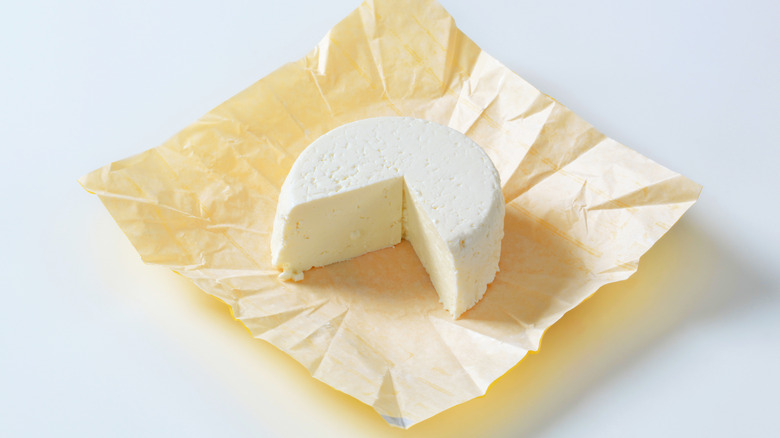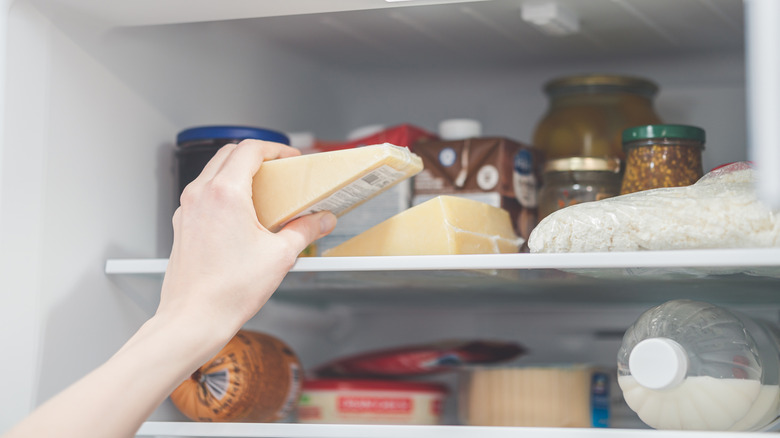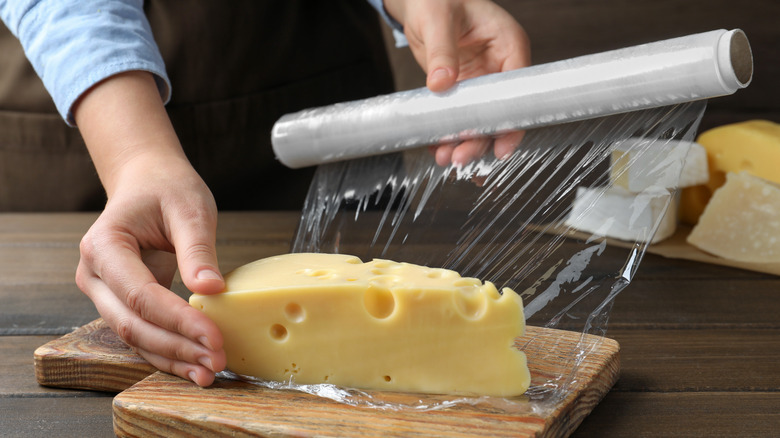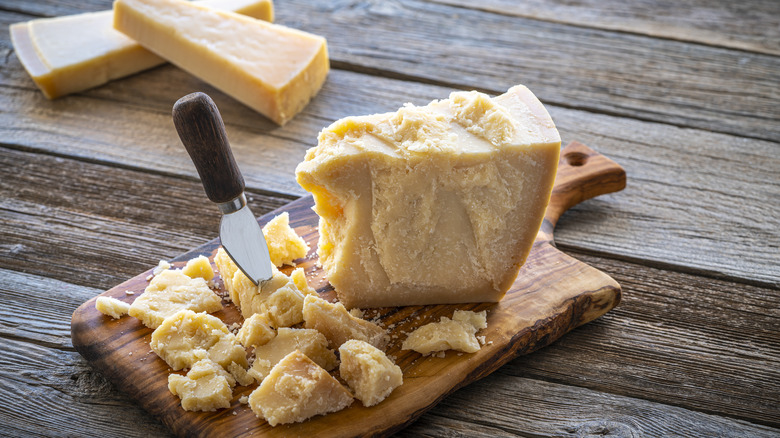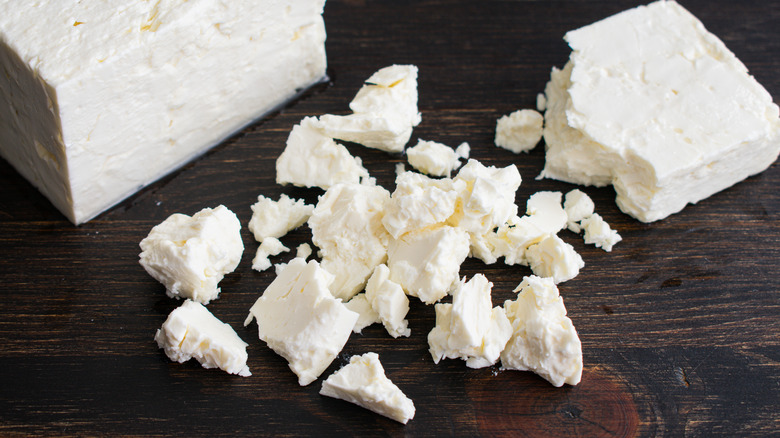The Dos And Don'ts Of Refrigerating Cheese
Cheese is a versatile food with so many varieties, styles, and flavors that it can be hard to understand how to store the different kinds correctly. Not all cheeses require refrigeration, but cold storage is a must for many types. Most importantly, refrigeration slows the rate of both the aging process of cheese and the growth of bacteria, keeping your cheese delicious and safe to consume for days or weeks to come.
Emiliano Tatar, owner and cheesemaker of Merion Park Cheese Co. in Merion Station, Pennsylvania, provides some tips on the dos and don'ts of refrigerating cheese. Tatar, along with co-makers Paul and Cerise Fereshetian, owners of Erivan Yogurt, are known for producing an artisanal Armenian labneh cheese they've named Loveneh. The cheese is made in suburban Philadelphia and previously wasn't a style easily found in this corner of the globe.
Whether you're a fan of mild cheddar, creamy Brie, or pungent blue, these tips will help you properly store your cheeses to keep them in good condition and prevent spoiling and mold (except when the mold is there on purpose, of course).
Do refrigerate fresh, soft, and crumbled cheeses
If you're in doubt about whether a cheese needs to be refrigerated, remember that hard cheeses don't always need refrigeration, but for safety reasons, soft cheeses do. Cheesmaker Tatar states that all fresh cheeses, meaning any that are soft or spreadable, should be kept refrigerated to prevent spoilage, saying that "these products have a high moisture content and are easily contaminated with the molds we all have in our home environments."
Soft cheeses include such varieties as Brie, goat cheese, cream cheese, cottage cheese, queso fresco, ricotta, blue cheese, and fresh mozzarella. As they are more delicate and prone to spoiling earlier than harder kinds, don't wait longer than a few days after buying these cheeses to consume them.
Any shredded cheese, for example, shredded mozzarella or cheddar used to top pizza and tacos, also need refrigeration, and so do crumbled cheeses like feta. Shredding or crumbling breaks the cheese up, causing it to lose moisture much more quickly than the original block. Refrigerator storage will extend the lifespan of these cheeses up to a few weeks.
Do store cheese in cheese paper
Cheesemakers agree that cheese paper is an ideal way to store cheese. This wrapping is a composite material with porous plastic on the inside and a waxy paper on the outside. "As odd as it may sound, cheese needs to 'breathe'," states Tatar. While we may not normally think of this food as a living thing, Tatar goes on to explain that breathing is necessary because cheese "is made with cultures (good bacteria) and desirable molds" and some of those "friendly organisms" are still alive when you purchase cheese. He cautions: "Depriving a cheese of air exchange can create off flavors and textures, so use wrappers that are porous. Ideally, use cheese wrapping paper (available at your local specialty cheese counter or online) or parchment paper."
Cheese paper has the added benefits of protecting the product from light, which can cause oxidation, and preserving an ideal level of humidity inside the wrapper. It will also keep undesirable aromas from other foods in the refrigerator from affecting the flavor of the cheese. This paper can be on the pricey side, especially for those who purchase cheese often. For those concerned that these materials cannot be reused or recycled, reusable beeswax wraps can be used instead if they are wrapped tightly around the product, although they may not work as well as cheese paper.
Do keep cheese in the right part of the refrigerator
Different parts of the refrigerator can have slightly different temperatures, and cheese will keep best away from the coldest parts of the fridge. What temperature is ideal for storing cheese? Tatar remarks that "Everyone's refrigerator is different, so recommending an ideal temperature for cheese storage is probably not helpful for most consumers. Having said that, temperatures of 40 to 45 degrees Fahrenheit are considered best."
Home refrigerators usually run colder than this, so the ideal place to store cheese is in the produce drawer because it's usually a little warmer than the open shelves. Avoiding the coldest areas will help keep the cheese from freezing as well, which is undesirable as it will change the flavor of the product.
In addition to temperature, humidity is also an important consideration. Tatar says, "Cheese needs higher humidity environments to stay at its best, longer. The highest humidity section in most fridges tends to be the fruit and vegetable drawers." The stable temperature and higher moisture level will protect the cheese from drying out and hardening.
Do check cheese regularly
When storing cheese, be mindful of its lifespan and don't keep it for too long. Even with proper storage, all cheeses will go bad eventually, so make sure to note expiration dates and check your cheese regularly for signs of spoilage. According to the USDA, hard cheeses can be stored for three to four weeks in the refrigerator (or up to six months if unopened). Once shredded, hard cheeses will last for one month. Soft cheeses, on the other hand, will stay fresh for up to one week in the fridge.
When checking cheese, be on the alert for mold growth. Tatar says that "for soft, spreadable cheeses, any appearance of mold should send the cheese to the garbage can," whereas "for hard cheeses, superficial mold that can be easily wiped off with diluted vinegar should be fine."
He points out that the flavor of certain cheeses will change for the worse if too much time passes: "Bloomy rind cheeses (with white, snowy rinds like Brie) and washed rind cheeses (those beautiful stinkers) tend to break down more quickly and 'ammoniate.' This isn't dangerous to consume, but it is not a very delicious experience." This goes for the texture too, as he warns: "Be mindful that the longer a hard, grating cheese is kept in the refrigerator, the less delicious it will likely be as it continues to dry and become overly hard. Having said all this — when in doubt, throw it out!"
Do wrap cheese properly
Cheese paper is the top choice for storing cheese because it is porous and allows the cheese to breathe while also keeping it away from the light. Parchment paper comes in second, while plastic wrap should be avoided whenever possible. No matter which wrapping material you use, for refrigerated cheese there are certain considerations that apply to the wrapping process itself.
Find a balance with the tightness. Don't wrap cheese too tightly because it can get hard, but don't wrap it too loosely either because it can grow mold. Replace cheese paper periodically because when cheese sweats and the moisture can reduce the porosity of the wrapper. The cheese won't be able to breathe as well, increasing the chance it will spoil faster. If you put the wrapped cheese in a container, keep the container loosely covered, again, not sealed, so the cheese can breathe.
On the other hand, hard and aged cheeses that don't need to be refrigerated will fare better when wrapped tightly and stored in an airtight container so they don't develop a harder consistency than intended. Store unrefrigerated hard cheeses in a cool, dark place away from direct sources of heat and light.
Do return cheese to room temperature before serving
Although it's important to store many cheeses in the refrigerator to keep them fresh, allowing them to warm up before serving is just as important. Whether you're serving a cheese board or using cheese as an ingredient, full appreciation of the flavors and textures is only possible after you warm cheese to room temperature. The animal fats that condense in the cold will relax and release their full flavors, and cheeses will also change from overly firm to a softer and creamier state. This will heighten the enjoyment of the cheeses and allow their intended tastes and textures to shine.
How far ahead of time should you take cheese out of the fridge? Tatar advises: "For soft, spreadable cheeses, give them 10-15 minutes at room temperature before consuming. For harder cheeses or cheeses intended to be eaten gooey (like many washed rind cheeses), wait at least 45 minutes. You will get the best experience in return for your patience."
Just make sure to put any leftovers back in the refrigerator after eating. According to the USDA, any perishable food left out for more than two hours (or one hour if the temperature is 90 degrees Fahrenheit or higher) should be tossed for safety.
Don't store cheese in plastic wrap
While it's a common move, storing cheese in plastic wrap in the refrigerator is a mistake. Even though this material is commonly used to keep food fresh, in the case of cheese, it traps too much moisture and doesn't allow the cheese to breathe. Tatar's advice is simple: "Avoid plastic wrap whenever possible." As he explains, cutting off the airflow to cheese changes the flavor and not in a good way. This is why he recommends porous wrappings only.
Cheese is mostly comprised of fats and oils and when stored in plastic wrap it will eventually pick up a plastic flavor from the material. Plastic is not a flavor note most people are aiming for. Another problem with plastic wrap is that, as it seals cheese so tightly, it will allow ammonia to build up inside with no way to escape. Ammonia is a normal product of cheesemaking but, if it's not released, the excess negatively affects the flavor of the cheese. If this happens, allow the cheese to sit out without the wrapper for an hour until any unappetizing odors have disappeared.
Don't store certain kinds of cheeses together
Cheese lovers know it can be hard to pick just one (or three) cheeses to keep in. The good news is if you are storing many varieties in your refrigerator at once, you don't have to worry about keeping them all separated. However, there is one exception. Tatar says, "Keep blue cheeses separate as blue mold likes to jump onto neighboring cheeses." As undesirable as this will usually be, rest assured, he offers a couple of interesting solutions: "If this happens, you can cut out the portion with blue contamination or ... take a bite ... you may have created a delicious hybrid."
Storing pungent cheeses separately will also help keep their strong aromas and flavors contained and away from your milder choices. On a similar note, don't keep cheese in close proximity to highly aromatic foods like garlic, leeks, citrus, fish, hard-boiled eggs, ginger, and cilantro. Keep these foods out of the produce drawer if you store cheese in there, or wrap them separately and place them on a different shelf. Cheese can easily absorb other flavors.
Don't refrigerate cheeses that don't need refrigeration
Hard, aged cheeses were originally produced in the days before refrigeration to make fresh milk last longer and provide food for the winter. The cheeses were stored for months in cool places like caves or cellars that were naturally humid. Such cheeses don't need to be refrigerated even today. As Tatar explains: "The drier the cheese, the less prone it will be to spoilage. Harder cheeses like Parmigiano Reggiano or mature cheddars are pressed under pressure and aged longer, so their moisture content is lower." Low moisture content means it's less likely that bacteria will grow in the cheese.
Some hard cheeses that can be left out of the fridge are aged Gouda, Provolone, Asiago D'allevo, Pecorino Romano. and Appenzeller. In addition, processed cheeses like American cheese — unopened or opened — don't need to be refrigerated because pasteurization keeps bacterial growth in check.
Even though hard cheeses don't need to be kept in the refrigerator for safety reasons, Tatar explains they will keep longer in the fridge. His advice is to "buy amounts you can use up within one to two weeks and buy more when you're running out." Keep unrefrigerated cheeses in an airtight container to prevent them from losing moisture and, ideally, store them in a cellar. If that's not available, store them in a cool, dark place away from sources of heat.
Don't freeze cheese
Cheese can technically be frozen for up to six months, but beware — it won't be the same afterward. The ice crystals that form inside actually change the cheese's structure, and the texture and flavor will take a nosedive after time spent on ice. As a general rule, hard cheeses fare better in the freezer than soft cheeses do. In particular, ricotta, cottage cheese, and cream cheese don't hold up well. While defrosted cheeses are still safe to eat, the structural change makes them grainy and liable to crumble. It will be more difficult to cut them into intact, moist slices, so eating them straight is liable to be a disappointing experience. As a result, previously frozen cheeses are best saved for cooking, as their ability to melt won't be affected.
It's not worth the risk for any artisan or specialty cheeses. Tatar says: "Don't freeze your fancy-pants expensive cheeses. The freezing and defrosting process can affect texture and taste and this will be sad for the cheesemaker who spent months producing a milky masterpiece." He mentions that for "commodity cheeses (bulk cheddars, grated parmesan or inexpensive Bries), you can try freezing but make sure to seal very tightly, ideally, vacuum seal." The goal is to reduce the cheese's contact with the surrounding air as much as possible.
Don't lose track of fridge maintenance
Is deep cleaning your refrigerator on your calendar at regular intervals? Many people neglect this task, but a clean refrigerator will provide a much better environment for cheese storage. The main issue is mold. Most of us are guilty of forgetting about something in the back of the refrigerator only to find it blue and fuzzy some time later. Mold can spread to other food items and other parts of the fridge via the appliance's ventilation system. Soft cheeses in particular are easily contaminated by mold because of their high moisture content, but the spores can make themselves at home in any type of cheese.
Odor is another issue. Mold can create unpleasant smells in the refrigerator, and trying to mask those odors with things like lemon juice or baking soda will only work temporarily. The mold itself must be removed. It is much easier to prevent it from setting up shop in the first place by giving your refrigerator a good cleaning every few months. This is especially important for cheese storage because cheese can absorb surrounding odors and flavors.
Don't forget to change the wrapping
If you purchase cheese wrapped in plastic, take it out of the wrapping as soon as you bring it home to avoid any further plastic odor from transferring onto the cheese. In addition, cheese wrapped tightly in plastic wrap has no way to breathe, so the natural moisture in the cheese may have found its way down to the bottom, saturating the rind. In case this has happened, changing the wrapper will let the humidity levels adjust back to normal. The cheese will have the right consistency and last longer.
Ideally, Tatar recommends changing the wrapping "every few days." He explains that "layers of rind can stick to the wrapper and deteriorate, causing off flavors and clogging up those important breathing holes." Another concern is that bacteria from your hands can contaminate cheese if you touch the wrapping and then use it to wrap the cheese up again, so occasionally substituting a new wrapper can reduce this risk. If you're concerned about waste, know that you can save cheese paper, give it a good rinse, blot it dry, and use it again in the future.


